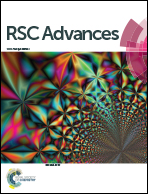Biomilling of rod-shaped ZnO nanoparticles: a potential role of Saccharomyces cerevisiae extracellular proteins†
Abstract
There is a tremendous interest in newly-discovered, green, room-temperature, biological routes for the fabrication of biologically-benign functional nanostructures. The bottom-up biogenic synthesis, where the precursor molecules form crystalline solids at the nanoscale by a redox process, has been validated over the years and gained its popularity. However, a new top-down technique has recently been developed by our group, in which small isotropic nanoparticles (NPs) are formed by the break-down of chemically-synthesized anisotropic rod or plate-shaped NPs using microbes (termed as biomilling). This technique, which holds great promise, is still in its infancy. Here, an improved process with an easy isolation of NPs from the biomass and better control of the technique is reported. This novel technique is demonstrated to break-down the chemically synthesized ZnO nanorods (NRs), ∼250 nm in length, to small quasi-spherical ZnO NPs (∼10 nm in diameter) possibly due to the proteins secreted by the yeast (Saccharomyces cerevisiae), which also led to the formation of “corona” around the NPs. The UV-vis, PL and FTIR results show the dynamic nature of the protein corona, which is further supported by the SDS-PAGE study of the extracellular proteins. The SDS-PAGE study of the intracellular proteins shows the over-expression of a single protein which is supposed to have a role in zinc transport in the cells. The ICP-OES results show the accumulation of a higher amount of zinc in the yeast cells as biomilling progresses, while the extracellular zinc contents were almost same. Therefore, we believe that the yeast cells play an important role in the biomilling process by secreting the proteins and maintaining the zinc content in the extracellular fluid. The biomilled NPs exhibit a uniform dispersity and better aqueous stability than chemically synthesized ZnO NRs.


 Please wait while we load your content...
Please wait while we load your content...